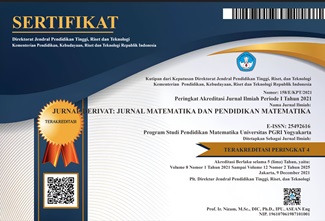Etnomatematika Pada Bentuk Bangunan Keraton Kusuma Negara Di Sekadau Hilir
DOI:
https://doi.org/10.31316/jderivat.v11i1.5135Abstract
Abstract
this study is a mathematical study that deals with exploring the application of the concept of ethnomathematics in the design of palace buildings in Sekadau Hilir. Through ethnographic approaches and mathematical analysis, this study aims to understand and describe how local communities use mathematical knowledge in creating unique kraton. The research method used involves the collection of field data through observation, and visual documentation. The collected Data were then analyzed using ethnographic approaches and relevant mathematical concepts. The results of this study revealed that the design of the palace building in Sekadau Hilir reflects the use of geometric patterns, symmetry, and mathematical proportions that are integrated with the local culture and environment. This article also highlights the role of ethnomathematics in respecting and preserving local knowledge and promoting recognition of cultural diversity. The practical implications of this study are to provide insights for designers , architects, and other relevant practitioners to broaden their perspectives in creating designs that relate to cultural and mathematical values.
Keywords: Ethnomaematics, geometric patterns.
References
Utami, S. (2021). Proses Penyesuaian Kode Bahasa Dalam Komunikasi Antarbudaya (Doctoral dissertation, UMSU).
Kurniawan, W., & Hidayati, T. (2020). Etnomatematika: Konsep dan eksistensinya.
Sudaryono, dkk. 2013. Pengembangan Instrumen Penelitian Pendidikan. Yogyakarta: Graha Ilmu.
Danim, S. 2013. Menjadi Peneliti Kualitatif. Bandung: Pustaka Setia.
Sugiyono. 2019. Metode Penelitian Kuantitatif, Kualitatif, dan R&D. Bandung: Alfabeta, cv
Arikunto, S. (2013). Dasar-Dasar Evaluasi Pendidikan Edisi 2. Jakarta: PT Bumi Aksara
Bayazid Bustami, A. (2023). Etnomatematika: analisis penggunaan konsep bangun datar dan bangun ruang pada objek" Tangkak Gula" (Doctoral dissertation, UIN Mataram).
Hodiyanto. 2019. Geometri Dasar. Pontianak: Fakultas Pendidikan MIPA dan Teknologi.IKIP-PGRI Pontianak.
Syahbana, A. 2014. “Alternatif Pemahaman Konsep Umum Luas Daerah Suatu Bangun Datar”, dalam Edumatica, Vol 04 No 2, 11-18.
D'Ambrosio, U. (2001). Etnomatematika: Sebuah Pengantar. Majalah Pendidikan Matematika, 20(2), 48-58.
Nur, M. A., Wirawan, R., & Inayah, A. (2023). Media Pembelajaran Matematika Materi Pokok Bagun Datar Berbasis Augmented Reality. Justek: Jurnal Sains dan Teknologi, 6(1), 30-39.
Jatia, S. P., Mastur, Z., & Asikin, M. (2019). Potensi Etnomatematika untuk Mengembangkan Kemampuan Komunikasi Matematis. Prosding Seminar Nasional Matematika Dan Pendidikan Matematika, 2, 277–286.
CHAIRUNNISA, C. (2022). EKSPLORASI ETNOMATEMATIKA PADA TRADISI SAPRAHAN ADAT MELAYU DI KERATON KADARIAH PONTIANAK (Doctoral dissertation, IKIP PGRI PONTIANAK).
Wahyuni, A., Aji, A., Tias, W., & Sani, B. (2013). Peran Etnomatematika dalam Membangun Karakter Bangsa: Penguatan Peran Matematika Dan Pendidikan Matematika Untuk Indonesia Yang Lebih Baik, 1, 111–118.
Sabarno, S., Halini, H., Rustam, R., & Fitriawan, D. (2022). Etnomatematika Pada Keraton Alwatzikhoebillah Sambas Sebagai Sumber Belajar Matematika Materi Geometri. EQUALS: Jurnal Ilmiah Pendidikan Matematika, 5(1), 1-12.
Downloads
Published
Issue
Section
Citation Check
License
Copyright (c) 2024 Riski Suwanto

This work is licensed under a Creative Commons Attribution-ShareAlike 4.0 International License.
Authors who publish with this journal agree to the following terms:
-
Authors retain copyright and grant the journal right of first publication with the work simultaneously licensed under a Creative Commons Attribution-ShareAlike 4.0 International License that allows others to share the work with an acknowledgment of the work's authorship and initial publication in this journal.
- Authors are able to enter into separate, additional contractual arrangements for the non-exclusive distribution of the journal's published version of the work (e.g., post it to an institutional repository or publish it in a book), with an acknowledgment of its initial publication in this journal.
- Authors are permitted and encouraged to post their work online (e.g., in institutional repositories or on their website) prior to and during the submission process, as it can lead to productive exchanges, as well as earlier and greater citation of published work (See The Effect of Open Access).







